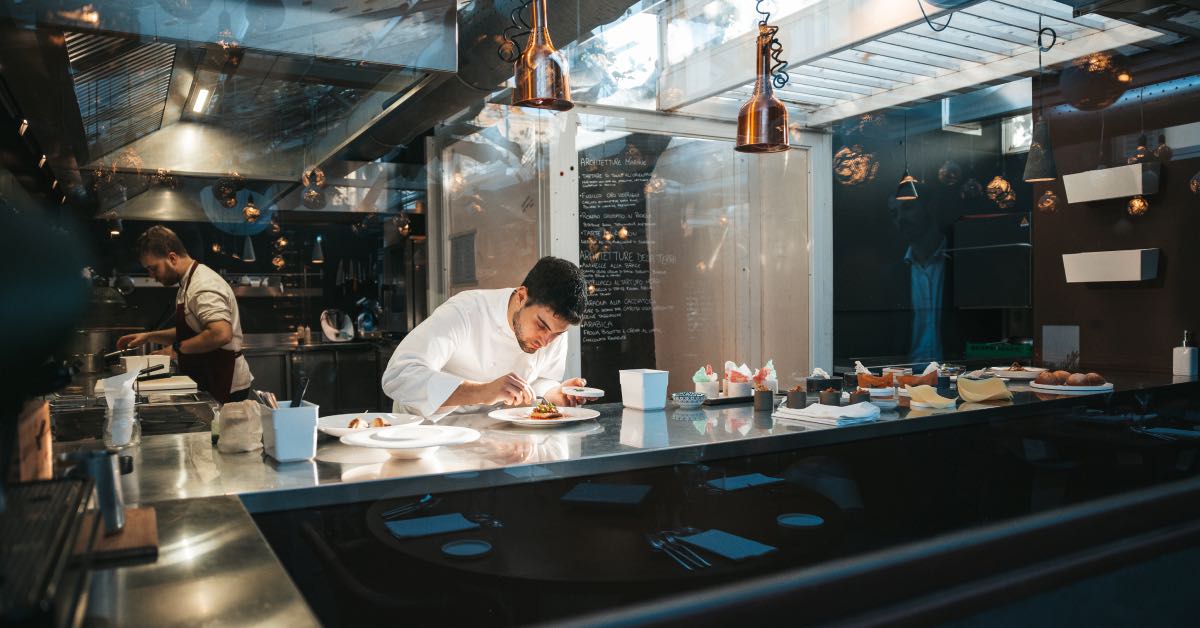
The kitchen is the heart of the restaurant. What comes out of it (and how quickly it comes out) makes or breaks the dining experience for customers.
A commercial kitchen’s layout can determine how smoothly the restaurant functions. When the kitchen is designed strategically, it enables the back-of-house team to work efficiently and produce high-quality meals consistently. When the kitchen is put together haphazardly, it can become an obstacle for the BOH. In a poorly designed kitchen, staff can’t be as efficient because they have to worry about bumping into each other.
A successful commercial kitchen layout is easy to use, meets the restaurant’s needs and enables your service staff to deliver an amazing restaurant experience. Whether you’re building a restaurant from scratch, or have (literally) hit a wall with your current design and need to renovate, you’ll become a commercial kitchen layout expert after reading this guide.
In this blog post you’ll learn:
- The five types of commercial kitchen layouts
- The five key components of a commercial kitchen
- The most important commercial kitchen layout considerations
Create a standout restaurant experience
Smart, scalable, dependable. Run your entire restaurant from Lightspeed's all-in-one platform.
5 types of commercial kitchen layouts
Now that you understand the components of a functional commercial kitchen, and have thought about elements such as safety and ergonomics, it’s time to start designing your restaurant’s kitchen. Take inspiration from these five popular commercial kitchen layouts.
Commercial kitchen layout types
- Assembly line layout
- Island layout
- Zone-style layout
- Galley layout
- Open kitchen layout
1. Assembly line layout
The assembly line configuration consists of a central row or island that starts with food prep and ends with a completed item that is ready to be taken to your guests.
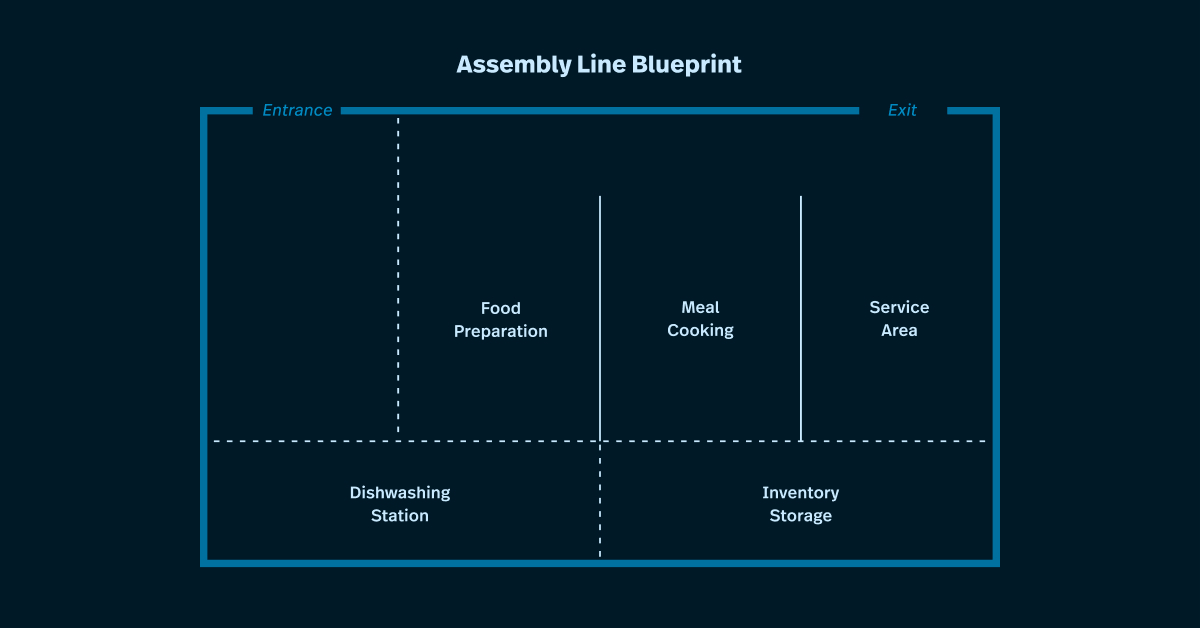
The benefits of the assembly line layout
This commercial kitchen layout facilitates the production of lots of the same type of dish over and over again. The assembly line works best with multiple cooks who are each responsible for one part of the food production process. This type of layout is ideal for quick-service types restaurants that need fast output.
Disadvantages of an assembly line layout
While the assembly line layout is definitely built for speed, it might not be right for all restaurant types. Since it’s created for a linear preparation process and focused on repetition of specific actions, this layout type can limit the flexibility you have to change the menu. The focus on speed and efficiency can also lead to lower quality and lack of personalisation or creativity.
Which restaurant types is the assembly line layout best for?
The assembly line layout is best for fast food restaurants or restaurants with limited menus that have similar preparation styles, like pizza parlours or build-your-own bowl restaurants.
Examples
Fast-casual chains like Chipotle and Sweetgreen use an assembly line configuration in the customer-facing side of their kitchens.
2. Island layout
The island commercial kitchen layout starts with the ring layout and adds a central preparation or cooking station. For example, a kitchen may have storage units, washing stations and food prep counters along its perimeter and cooking equipment in its centre.
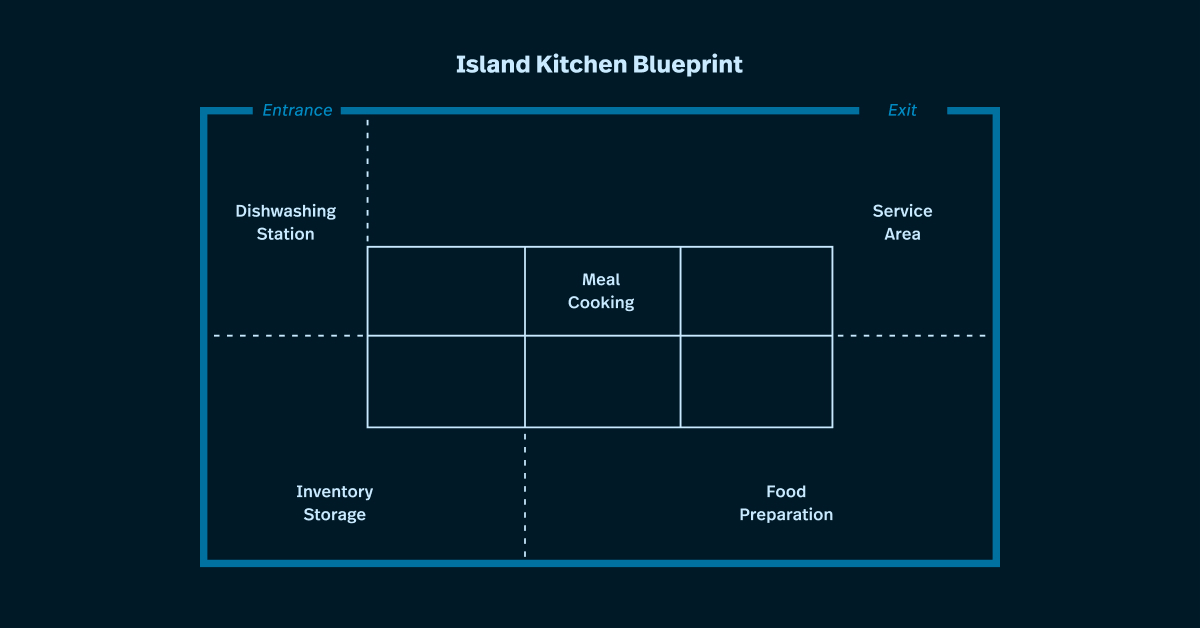
The benefits of the island kitchen layout
With a central “command centre” or passthrough point for all meals, the island configuration facilitates staff communication and executive chef supervision.
Disadvantages of an island kitchen layout
The island kitchen layout is a popular option for home kitchens. In a restaurant setting, however, it can pose some challenges. Without the linear assembly line layout, an island kitchen requires a bit of coordination and communication between food preparation and food cooking areas. This layout might also not work as well for smaller kitchens since the main island requires much more room.
Which restaurant types is the island kitchen layout best for?
The island setup is best for restaurants with ample kitchen space to ensure that the island doesn’t create an obstacle for the BOH team.
Examples
You can watch the island layout in action at the Dutch restaurant Latour.
3. Zone-style layout
A zone-style layout creates separate stations for each type of activity that goes on in the kitchen or for each kind of dish that is prepared in it. For example, a restaurant could have a soup and salad station, meat station, frying station, and baking station.
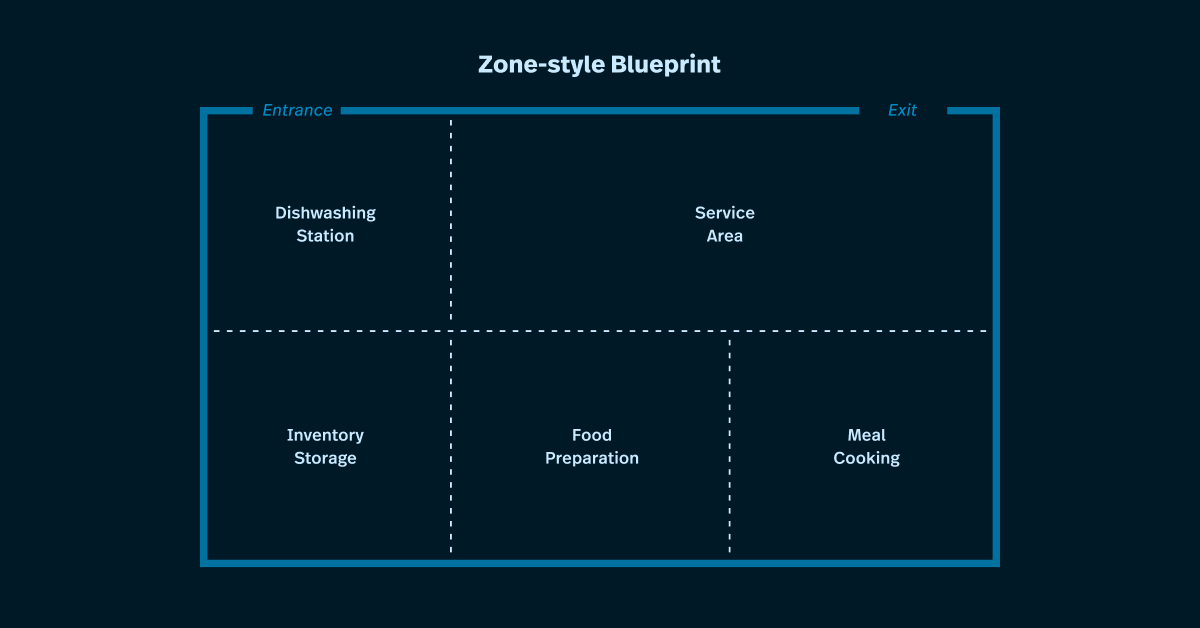
The benefits of the zone-style layout
This commercial kitchen layout keeps the kitchen organised and allows different types of dishes to be prepared at the same time. This layout helps BOH staff divide and conquer. You can hire a specialised chef for each station rather than a line cook to create everything from start to finish.
Disadvantages of a zone-style layout
While great for specialised cooking, this type of layout can be much more expensive to set up. Each area or zone might require different types of specialised equipment and even things like ventilation. All of this can add up to higher initial costs, as well as energy and maintenance costs. The zone-style layout is also not suitable for all types of restaurants. Restaurants with smaller menus would not benefit from a complex multi-zone layout.
Which restaurant types is the zone-style kitchen layout best for?
This commercial kitchen layout is best for restaurants with diverse menus and lots of staff. The station layout is suited for large operations like hotel restaurants, catering kitchens or event space kitchens.
Restaurants with small kitchens should avoid the station-based configuration as it doesn’t allow for multitasking. You’ll need ample space and staff to make this type of kitchen function smoothly.
Examples
You can see examples of station-based commercial kitchen layouts here and here.
4. Galley layout
In this commercial kitchen layout, all stations and equipment are on the perimeter of the kitchen. In a very tight space, kitchen equipment is placed along only parallel two walls. This layout is mostly used in small commercial kitchen settings.

The benefits of the galley layout
If your kitchen is large enough to have a ring layout with empty space in the centre, you can have multiple cooks in the kitchen and they can easily rotate to work multiple stations at once. In a very small space, like a food truck, the galley kitchen is the only option the space allows.
Disadvantages of the galley layout
This type of kitchen is mostly used for smaller operations that have limited space and need to be as efficient as possible in terms of production. A galley layout doesn’t work for bigger restaurant operations. For parallel stations, the space can become too cramped and it doesn’t allow for a high volume of food production. There’s limited room for food prep and this can lead to longer wait times for customers if a higher volume of people show up.
Which restaurant types is the galley kitchen layout best for?
The ring and galley style commercial kitchen layouts are best for tight spaces. with few staff, such as food trucks.
Small commercial kitchen layout examples
Kitchens with long, narrow spaces and pretty much any food truck.
5. Open kitchen layout
An open kitchen layout lets customers see the action that usually takes place behind the scenes. Any commercial kitchen layout can be turned into an open kitchen by taking down a wall.
To ensure guest safety, it’s best to keep hot cooking appliances as far away from customers as possible. A glass partition between the service area and guest seating is a smart choice to protect the food from unexpected sneezes or coughs.
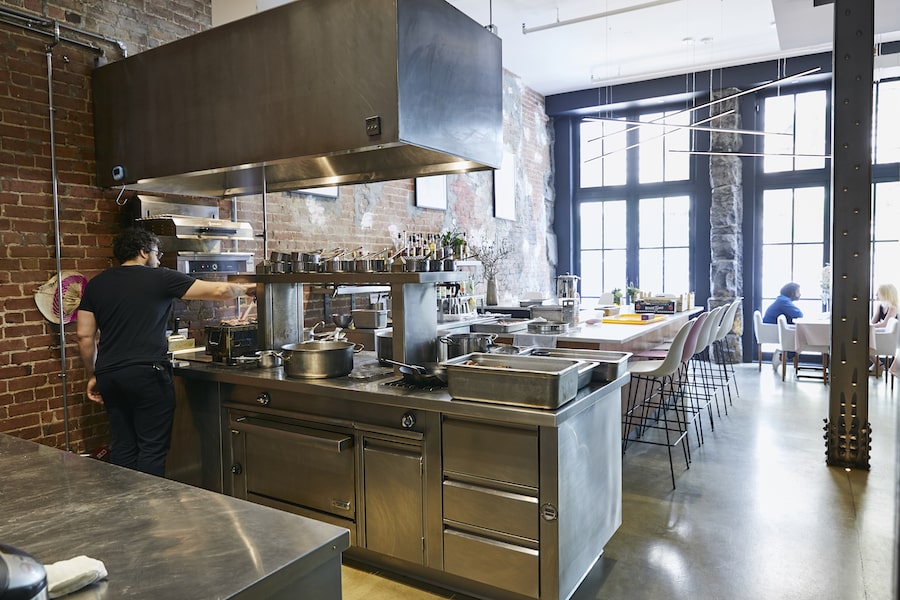
In the example above, Lightspeed customer Pastel, named one of Canada’s 100 best restaurants, has an open kitchen layout that lets guests see executive chef Jason Morris and his team prepare dishes with precision.
The benefits of the open kitchen layout
The open kitchen is great for entertaining guests. An open kitchen is also a good opportunity to maximise a small space. You can create chef’s table seating by placing bar stools by the kitchen.
Disadvantages of an open kitchen layout
While an open kitchen concept can add a unique industrial element to your restaurant, it comes with drawbacks. Loud noises and messes from hectic kitchens can create a distracting dining experience. Smells coming from the kitchen can also diminish the actual ambiance of the restaurant and the meal the customers are having.
Finally, an open kitchen layout can also be problematic when it comes to cross contamination and even concerns for food allergens.
Which restaurant types is the open kitchen layout best for?
Open layout kitchens are typically seen at high-end restaurants or restaurants with small commercial spaces. Watching the cooks prepare dishes becomes an integral part of the dining experience.
Examples
Sampan in Philadelphia and Minibar in DC have open kitchens and chef’s table seating.
The 5 key components of a commercial kitchen layout
Before designing a commercial kitchen layout for your space, it’s important to account for the needs that the kitchen must fulfil and the equipment associated with those needs. When you know what components need to fit into the space from the beginning of the design process, you will be able to design your restaurant kitchen layout more effectively.
The 5 components of a commercial kitchen
- Storage
- washing station
- Food preparation
- Cooking station
- Service area

1. Storage
Your restaurant’s kitchen will store a variety of items including cooking tools (utensils, pans, etc.), food (produce, meats, dry goods) and place settings (glasses, plates, linens).
Your kitchen will need separate storage units for each of these needs, such as a refrigerator for perishable foods, a pantry for dry goods and cupboards for place settings and tools.
2. Washing station
A lot of cleaning goes on in a commercial kitchen to ensure the safety of the food that’s being served and the dishes that it’s being served on. We recommend creating separate washing stations for food and for dishes so that dirty dish suds never land on clean produce!
Your washing stations will need commercial dishwashing machines, sinks and drying racks to run smoothly.
3. Food preparation
A commercial kitchen may have several food preparation areas depending on what kind of food is on the menu. The food prep section of a restaurant’s kitchen consists of counter space, cutting tools and storage containers.
Place food preparation zones near a refrigerator so that your BOH team can quickly and safely store raw ingredients until they’re ready to be used.
4. Cooking station
Unless your restaurant’s concept is raw foods, your kitchen will need quite a bit of cooking equipment to execute your menu. Most restaurants have gas range-oven combinations, commercial fryers, and a few specialised cooking appliances. A kitchen display system makes it easy for BOH staff to keep up with incoming tickets.
5. Service
A commercial kitchen’s service area is used for plating dishes and handing them off to servers to deliver to diners. A service area should have heat lamps to keep food warm.
Place your kitchen’s service area as close to the dining room as possible to lessen the distance from the kitchen to the table for waiters.
The most important commercial kitchen layout considerations
Now that you understand the key components of a commercial kitchen layout, you must also factor a few crucial considerations into your kitchen’s design in order to ensure that it’s safe and functional.
Ergonomics
According to the Merriam-Webster Dictionary, ergonomics is the science behind “designing and arranging things people use so that the people and things interact most efficiently and safely.”
In order to create a functional, user-friendly commercial kitchen layout you must take into consideration how much equipment the kitchen will need to hold, how many people will be in the kitchen and the flow of the staff’s routes between stations.
Space
How much room you have to work with will limit which commercial kitchen layouts you can adopt. Industry guidelines recommend dedicating 60% of your commercial space to the front of house and reserving the remaining 40% for back of house.
So if your restaurant has an area of 500 square feet, 300 square feet would be used for the dining area and waiting room, and the remaining 200 square feet would be used for the kitchen.
Staff communication
Don’t forget about the human elements of designing a space. Facilitate staff interaction and communication with an open floor plan instead of a maze-like kitchen with walled-off sections. Make it easy for executive chefs and managers to oversee what’s going on in the kitchen so that they can train and communicate with staff.
This consideration may be more important in a fast-food environment with inexperienced staff than at a high-end restaurant with experienced chefs.
Safety
Safety and design go hand in hand. First, you need to consider food safety in your restaurant. Design a space that keeps food safe for consumption. A few simple ways to do this include placing your receiving area near the fridge and avoiding cleaning chemicals near food.
You’ll also need to check local regulations to ensure that your restaurant takes food safety precautions that go beyond common sense. In some states, local regulations may determine your commercial kitchen’s layout or design elements.
For example, Missouri’s food code prohibits the use of wood as a food preparation surface (with a few exceptions) and prohibits carpeting in a commercial kitchen. Check local commercial kitchen laws to ensure that your restaurant is up to code.
You should also take your staff’s health into consideration as you design your commercial kitchen. Build proper ventilation into the space. Place mats on the ground to reduce knee and back wear-and-tear from standing.
Fire safety is another major element you must take into consideration while designing a safe restaurant kitchen. Create fire exits. Install smoke detectors and fire extinguishers. Work with your interior designer to make room for everyday kitchen equipment into your space and emergency tools.
Technology
Advances in tech are increasingly revolutionising commercial kitchens. Incorporating modern tech like digital inventory tracking, smart appliances, and energy-efficient lighting can streamline operations.
Keeping tech in mind when structuring your commercial kitchen layout not only boosts productivity but also helps in monitoring and reducing waste, leading to a more sustainable and cost-effective operation.
So when planning the layout of your kitchen, you want to consider restaurant technologies like automated ordering systems, AI-driven cooking equipment, and IoT sensors.
Many contemporary restaurants now feature kitchens equipped with touch-screen ordering systems, programmable ovens, and smart refrigeration units that alert staff when temperatures fluctuate. These examples illustrate how technology not only aids in day-to-day tasks but also elevates the overall culinary experience for both staff and customers.
Sustainability
Embracing sustainability in kitchen design involves using eco-friendly materials, such as recycled or renewable resources, and implementing practices that reduce environmental impact. Consider installing energy-efficient appliances, using water-saving devices, and choosing non-toxic, sustainable building materials when setting up your kitchen.
Waste management reduction should also be a consideration, so set up your kitchen in a way that minimises food waste.
Lastly, we have energy conservation. This is a key aspect of a sustainable kitchen and can be achieved through the use of ENERGY STAR-rated appliances, LED lighting, and smart kitchen design that minimises heat and energy loss. Implementing these practices not only reduces the carbon footprint but also lowers operational costs in the long run.
Choosing the right commercial kitchen layout for your restaurant
Strategic design makes a kitchen functional and safe. The right commercial kitchen layout enables a BOH team to do their best work safely and efficiently, resulting in lower staff turnover and higher customer satisfaction. However, there is no one kitchen layout that’s better than the rest.
Victor Cardamone, owner of restaurant kitchen design firm Mise Designs, says that your ideal commercial kitchen layout is entirely dependent on your kitchen space’s size and shape. “If your restaurant space has a long, narrow kitchen space, then an assembly line layout will be most effective, whereas if the kitchen space was a square room, an island layout would be more appropriate. Context is everything.” You should never force a kitchen layout type into a space that wasn’t designed for it.
With that in mind, Cardamone suggests following these steps when evaluating a commercial space’s ideal kitchen layout:
- Create a process to execute each menu item
- Develop an equipment list for each kitchen station based on menu requirements
- Organise or design the equipment layout for each station
- Arrange the stations next to each other that share menu components
- Determine your service process to complete dishes for delivery to the customer
- Design your expediting station and place it at the center point of all culinary stations
- Understand your building limitations and be willing to find alternate execution and service delivery methods to accommodate
- Visualise a dry run, executing each menu item in your new kitchen to ensure they are created and delivered efficiently
When you’re looking for the ideal commercial space for your restaurant, you need to actively assess the space’s potential. Which type of restaurant kitchen layout works best for your service type and the kitchen space? If you’re having issues pinpointing which of the five kitchen layouts will work best, consider hiring professionals to help you out.
Streamline restaurant communications
An optimised restaurant kitchen layout will improve efficiency amongst kitchen staff, but don’t forget about the front of house. A one-stop restaurant management system improves staff communication, streamlines the ordering process and much more.
Want to see how? Talk to one of our experts to find out how Lightspeed can help.
FAQs
What is the typical layout of a commercial kitchen?
The typical layout of a commercial kitchen is designed for efficiency and safety, often incorporating sections such as food preparation, cooking, baking, dishwashing, storage (dry, cold, and non-food), and receiving areas. The layout is typically designed in a linear or zonal fashion to facilitate an organized flow of materials and personnel.
How should a commercial kitchen be laid out?
A commercial kitchen should be laid out based on the principles of the workflow: receiving, storage, food preparation, cooking, service, and cleaning. The layout should minimise cross-traffic to reduce contamination risks and ensure that the path from raw materials to finished product is straightforward and logical.
What is a good size for a commercial kitchen?
The size of a commercial kitchen varies significantly based on the size of the establishment it serves. However, a rule of thumb is that the kitchen should occupy about 30% of the total space of the restaurant. For example, a 2000 square foot restaurant might have a 600 square foot kitchen.
What are the 5 types of commercial kitchen layouts?
- Island Layout: Centralised cooking or preparation area with peripheral cleaning, storage, and food preparation areas.
- Zone-Style Layout: Distinct zones for different tasks (prepping, cooking, washing).
- Assembly Line Layout: Efficient for restaurants focusing on a limited menu where dishes are prepared in a line, such as fast-food or quick-service restaurants.
- Galley Layout: Efficient use of small spaces, with kitchen activities aligned along parallel walls.
- Open Kitchen Layout: Integrates the kitchen into the dining area, allowing guests to see the cooking process.
How do you structure a restaurant kitchen?
Structuring a restaurant kitchen involves:
- Defining workstations: For preparation, cooking, baking, dishwashing, etc.
- Efficient layout: Adopting one of the kitchen layouts (island, zone-style, assembly line, galley, or open kitchen) based on the restaurant’s concept.
- Equipment placement: Strategic placement for efficient workflow, adhering to safety and health regulations.
- Storage solutions: Adequate, accessible storage for dry, refrigerated, and frozen goods.
- Safety measures: Ensuring clear pathways, proper ventilation, and adherence to health and safety standards.
Do commercial kitchens have to be stainless steel?
While commercial kitchens often use stainless steel for surfaces and equipment due to its durability, ease of cleaning, and resistance to bacteria, it’s not a strict requirement. Other materials can be used, especially in areas less prone to direct food contact, provided they meet local health and safety standards.
What is a commercial kitchen workflow?
A commercial kitchen workflow refers to the systematic process of food preparation from receiving raw materials to serving the finished product. It includes receiving, storage, preparation, cooking, plating, and serving, structured to minimise cross-contamination and ensure efficiency.
How does the layout of a commercial kitchen affect workflows?
The layout directly impacts workflow efficiency, safety, and food quality. A well-designed layout minimises unnecessary movement, reduces cross-contamination risks, and ensures smooth transitions from one stage of preparation to another, significantly affecting the speed and quality of service.
What is the difference between a regular kitchen and a commercial kitchen?
Commercial kitchen and regular kitchens differ in the following ways:
- Size and capacity: Commercial kitchens are larger and designed to serve many customers, unlike home kitchens.
- Equipment: Commercial kitchens use industrial-grade equipment designed for high volume and efficiency.
- Layout: Commercial kitchens are laid out to optimise workflow and safety, following health regulations.
- Materials: Surfaces and equipment in commercial kitchens are typically made from durable, easy-to-clean materials like stainless steel to meet health standards.

News you care about. Tips you can use.
Everything your business needs to grow, delivered straight to your inbox.





